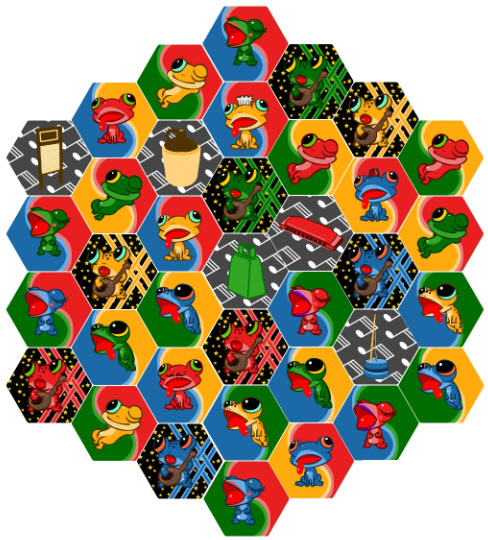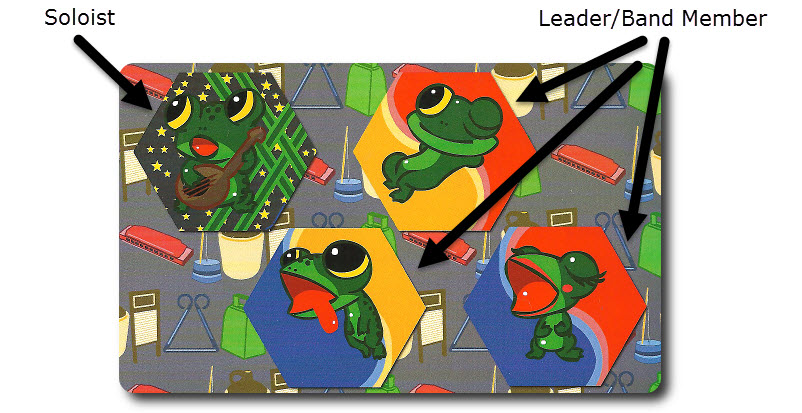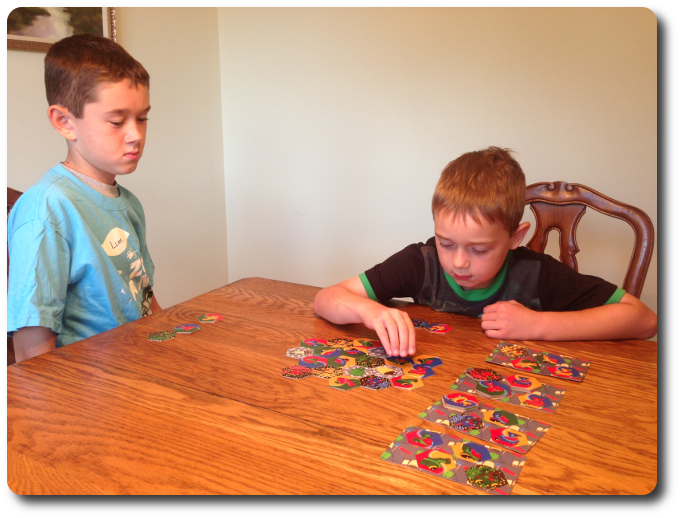
The Basics:
- For ages 8 and up (publisher suggests 12+)
- For 2 to 5 players
- Approximately 45 minutes to complete
Geek Skills:
- Counting & Math
- Logical & Critical Decision Making
- Pattern/Color Matching
- Strategy & Tactics
- Hand/Resource Management
Learning Curve:
- Child – Easy
- Adult – Easy
Theme & Narrative:
- Assemble the best frog band to get the audience hopping
Endorsements:
- Gamer Geek rejected!
- Parent Geek approved!
- Child Geek approved!
Overview
The best music in the world is the kind that speaks to you on a deep and personal level. Of course, since we are all unique, one person’s favorite song is another person’s ear-bleeding noise. In this game, players will collect frog musicians in an attempt to create the perfect band. To do so, one must mix one part harmony with one part timing.
Song-Froggy, designed by Bryan Koch and published via the Game Crafter, is comprised of 6 Instrument tiles, 8 Blue Frog tiles, 8 Red Frog tiles, 8 Green Frog tiles, 8 Yellow Frog tiles, 4 Band cards (jumbo sized, if that is even a real size), and 2 Bonus cards. The tiles are hexagonal in shape and made of thick cardboard. The cards are as durable as your standard playing card. The Bonus cards are used to create a stage using the game’s boxes. The “box stage” has nothing to do with the game and was included as a fun additional perk. On the back of the tiles are random quotes and facts about frogs that are true, from a certain point of view. Not included with the game, but necessary to play, is a pen or pencil and some paper to keep track of the players’ scores.
Prepping for the Concert
To set up the game, first place all the tiles in the box and randomize them by mixing them up or closing the box and shaking it. Then remove 1 tile by blindly selecting it. Set the tile aside, removing it for the duration of the game.
Second, select 1 tile and place it in the middle of the playing area, face-up (a frog or instrument should be looking at you). Then draw another tile and place it adjacent to the previously placed tile. Continue to pull tiles to create 3 concentric circles around the initial tile that should be in the center. This is the “Lily Pad”.

Third, place the 4 Band cards to one side of the Lily Pad and within easy reach of all the players. The Band cards are double-sided, but each side has the same artwork.
Fourth, assign one player as the Score Keeper to keep track of everyone’s points. This helps the game move along.
That’s it for game set up. Let the concert begin!
Froggy Rock
Song-Froggy is played in turns with no set number of turns per round. On a player’s turn, they take 1 of 2 possible actions (not both). A player’s turn is summarized here.
Action Option 1: Take One Frog
The player will take 1 tile from the Lily Pad. There are 2 types of tiles. These are Frog and Instrument. The Frog tile has two sub-types referred to as a “Soloist” and “Leader/Band Member”.

The type of tile selected does not make an immediate difference, but the only tiles that can be removed from the Lily Pad are those that can be slid away. That is to say, removed from the Lily Pad without the need to move other tiles. A single tile will need at least 2 open sides to be removed. From the very start, the only tiles that meet this requirement are those located on the outside circle of the Lily Pad. As the game continues, the inside circle will become clear and the tiles that are part of it can be removed, as well.
Regardless of what type the tile is, the player receives 1 point for every tile that was touching it. For example, if the player removed a tile that was only adjacent to one other tile, they would receive 1 point. Because the tiles are hexagonal in shape and depending on where they are located, it’s possible to score up to 4 points by removing 1 tile from the Lily Pad.
Collected tiles are kept in front of the players, face-up.
Action Option 2: Assemble a Band
After the player’s second or third turn, a player might be able to assemble a “Band”. A Band must consist of either 1 Instrument tile and 1 “Soloist” Frog tile or 3 Frog tiles of 3 different colors. A Band is stacked together and placed on an open space on any of the 4 Band cards. Tiles can never be placed on top of previously placed tiles.
Going Solo
By combining a “Soloist” Frog and an Instrument tile, the player earns 4 points. A “Soloist” Frog tile does not have a colored background (background is stars and what might be a laser light show), which means they cannot be used as a “Leader” for a full band.

Three possible instruments to use to make your frog band rock the lily pad
A Full Band
A full band must include a “Leader” and 2 other Frog tiles. The Leader can be any Frog tile the player likes (except a “Soloist” Frog tile) and the two other Frog tiles must have a frog that matches 1 of the 2 background colors. For example, if the “Leader” Frog tile had a background color of red and blue, the 2 other Frog tiles in the Band MUST be 1 “Red” Frog tile and 1 “Blue” Frog tile”. These tiles are placed in a stack on a Band card with the Leader on top for a total of 4 points.
Bigger Venue
In addition to the points earned from placing a Soloist or a Band, the player earns 1 additional point for every tile space that is also filled on the Band card. For example, the first player to place a Band or a Soloist on a Band card will only earn 4 points. The next player to play a Band or a Soloist on the same card will earn their 4 points, plus 1 additional point from the previously played Band. The last Band or Soloist to fill the 4th space on the Band card will earn 4 points plus 3 additional points for a total of 7 points.
Perfect Harmony
If a player has 3 Frog tiles that could all be the Leader of the Band (meaning each Frog tile has the background color of the other two frogs), the player can split the 3 tiles across 3 different Band cards. They still earn 4 points for the Band and earn any additional points for creating a bigger venue, counting the Bands on the other Band cards.

Ending the Concert
The game ends when a players takes the last tile from the Lily Pad (earning the player zero points) as their action. The Score Keeper then announces the points earned by each player. Unplayed tiles do not penalize a player, but nor did they earn the player points. The player with the most points wins the game.
To learn more about Song-Froggy, visit the game’s web page.
Final Word
The Child Geeks enjoyed the game a great deal, but had a few rough starts. They had difficulty remembering that the “Leader” frog’s background color was used to match the Band member frog color. Not the Band member frog’s background. It normally took 1 game before all the Child Geeks fully understood that the background color of Band member frogs never mattered except when attempting a perfect harmony. Other than that, they played beautifully. They pulled tiles at just the right time and did their very best to place a Band on the Band cards that would earn them the most points. According to one Child Geek, “What I like most about this game is how you have to think about what tiles to pull and when to use them for points. You’ll want to hang on to some tiles just to go for the big points.” Since a player is never forced to pull a tile or a Band, the game challenges the player to consider what is the most important thing “now”. As one Child Geek put it, “You have to take some hits on your points if you want to make it big!” When all the songs were over, the Child Geeks voted to approve Song-Froggy.

The Child Geeks never had any problems deciding which tile to grab
The Parent Geeks also enjoyed the game, finding it to be an excellent mix of casual and light tactical game play. According to one Parent Geek, “This really is an easy game to learn how to play. The real difficulty is managing your tiles and knowing when to use them for the most points.” Since points are earned every single turn, a player was never left behind. They always moved forward, but only the players who created great Bands from the Lily Pad stayed ahead of the group. As one Parent Geek put it, “This is a game where everyone is moving forward. You have to kick it up a notch if you want to win.” All the Parent Geeks voted to approve Song-Froggy, having found it to be an enjoyable game with family and friends.
The Gamer Geeks were very critical of Song-Froggy. They liked the game’s idea, but not how it was executed. According to one Gamer Geek, “I don’t like that players can make lots of points just because of their turn order. Pulling tiles from the Lily Pad for points should just be about selecting the tiles you want, not about which tile will give you the most points right now.” Another Gamer Geek said, “Without any penalty to the player for keeping and not using tiles, the game is too easy and promotes game play that is not tactical or strategic. You tend to hoard tiles rather than use them.” Nor did the Gamer Geeks care for the Band cards. According to one Gamer Geek, “Stacking tiles and color matching is fine, but they are always worth the same amount of points. Further more, I get more points for waiting to put my Bands out on the Band card. This is backwards as it rewards a player to hold back. I think it should be the opposite. You get more points for being the first Band on stage and then fewer points for the second and so on.” When the games were over, the Gamer Geeks all agreed the game would be good for casual players, but not for the elitists.
Song-Froggy is a game in two parts. The first part is focused on the Lily Pad. Here players pull the tiles they need to create bands, but they also target those tiles that will reward them with the most points. This makes tiles that would otherwise not be desirable a very tempting grab. The second part is combining the tiles to create a Band. If the player grabbed tiles with a strategic and tactical plan, they won’t have much of an issue; however, many players will grab tiles they don’t need or cannot easily match because they rewarded points.
Song-Froggy asks players if they want 1 cookie now or 2 cookies later. Depending on the temperament of the player, they will either naturally gravitated towards short-term or long-term gains. It’s all about opportunity and timing, but neither path is really the right or wrong way to go. The Middle Way, as always, is best, but doesn’t feel like one you want to travel. It’s too tempting to get points early on and too big a rush to get lots of points at the end.
It was this “rushing” that left me feeling that I wasn’t putting much thought into the game. Oh, most certainly, it challenged me to consider which tiles to select and made me pause several times to consider when to place a Band, but the decisions were never hard. I always went for the points, which made each decision obvious. I only ever stopped to consider my choices to ponder my chances of making more points in the very near future. Which didn’t matter, as the goal of the game is to always make points now.
The end result is very fast game that always feels rewarding because it’s always giving you points. The problem is, if you always get points with ease, they tend to lose value and importance. The Lily Pad was almost always depleted before players started working on the Bands. The Gamer Geeks saw this as an issue right up front. For the Child Geeks and casual gamers like the Parent Geeks, the game’s rewarding game play kept them locked in and focused.
I would recommend Song-Froggy to casual players and non-gamers. The game goes out of its way to give the player points and keeping them happy with a melody that moves the game along. That’s great stuff for new players or inexperienced players who just want to play a game without feeling like they are being beat over the head. Those players who want a bit of risk and a real opportunity to lose the game no matter how hard they try will find Song-Froggy to be a tune they cannot whistle to.
This game was given to Father Geek as a review copy. Father Geek was not paid, bribed, wined, dined, or threatened in vain hopes of influencing this review. Such is the statuesque and legendary integrity of Father Geek.



